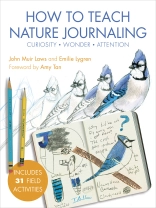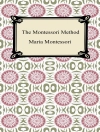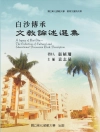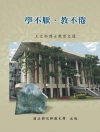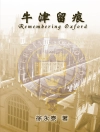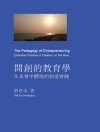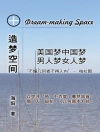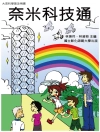The first-ever comprehensive book devoted to helping educators use nature journaling as an inspiring teaching tool to engage young people with wild places.
In their workshops, John Muir Laws and Emilie Lygren are often asked the how-tos of teaching nature journaling: how to manage student groups in the outdoors, teach drawing skills (especially from those who profess to have none), connect journaling to educational standards, and incorporate journaling into longer lessons. This book, expanding on the philosophy and methods of The Laws Guide to Nature Drawing and Journaling puts together curriculum plans, advice, and in-the-field experience so that educators of all stripes can leap into journaling with their students. The approaches are designed to work in a range of ecosystems and settings, and are suitable for classroom teachers, outdoor educators, camp counselors, and homeschooling parents.
Full-color illustrations and sample journal pages from notable naturalists show how to put each lesson into practice. Field-tested by over a hundred educators, this book includes dozens of activities that easily support the Common Core and the Next Generation Science Standards—and, just as important, it will show kids and mentors alike how to recognize the wonder and intrigue in their midst.
İçerik tablosu
TABLE OF CONTENTS
Foreword by Amy Tan
INTRODUCTION
Why We Teach Nature Journaling Why Nature Journaling? You Can Do This, and It Is Worth It MANAGING THE OUTDOOR CLASSROOM
Taking Students Outside How to Lead Journaling Activities Nature Journaling In Different Contexts THE NATURE JOURNAL QUICKSTART GUIDE
NATURE JOURNALING ACTIVITIES GETTING STARTED: INTRODUCTORY JOURNALING TECHNIQUES AND ACTIVITIES Use Words, Pictures, and Numbers Mix It Up I NOTICE, I WONDER, IT REMINDS ME OF MY SECRET PLANT TO EACH ITS OWN COMPARISON ZOOM IN, ZOOM OUT OBSERVATION AND NATURAL HISTORY Look Big, Look Small Make Comparisons and Study Categories Get Lost in Wonder COLLECTION OR FIELD GUIDE TIMELINE STRING SAFARI ANIMAL ENCOUNTERS SPECIES ACCOUNT FOREST KARAOKE: TRANSCRIBING BIRDSONG SOUNDSCAPE MAPS
INQUIRY, INVESTIGATION, AND SCIENTIFIC THINKING Intentional Curiosity and Inquiry The Crosscutting Concepts Who, What, Where, When, How, and Why International Baccalaureate Key Concepts How Do You Answer Your Questions? Ask Questions and Think Like a Scientist Practiced Precision Nature Puzzles Follow Curiosity Chains MYSTERIES AND EXPLANATIONS QUESTIONING QUESTIONS MAPPING LANDSCAPE CROSS SECTION PHENOMENON MODEL TEAM OBSERVATION
WORDS: ARTICULATED THOUGHT AND STORYTELLING Writing Find Poems within and around You Reflect, Connect, and Find Joy Practice Scientific Storytelling What Pictures Cannot Show WRITING TO OBSERVE, WRITING TO THINK EVENT COMIC EVENT MAP POETRY OF PLACE AND MOMENT SIT SPOT
PICTURES: DRAWING AND VISUAL THINKING Drawing Observational Drawing, Step-by-Step Building New Skills: Basic Drawing Exercises Drawing Tricks and Tips: Instruction for Students Page Structure and Layout THINK WITH PICTURES BALANCING FLEXIBILTY AND STRUCTURE LOOK, AND LOOK AGAIN INSIDE OUT NATURE BLUEPRINTS INFOGRAPHIC PHOTO, PENCIL, AND FOUND-OBJECT COLLAGE
NUMBERS: QUANTIFICATION AND MATHEMATICAL THINKING Numbers and Quantification Making Quantification Tool Kits SHOW WHERE THE NUMBERS COME FROM USE NUMBERS TO FIND THE PATTERN HIDDEN FIGURES BIODIVERSITY INVENTORY TIMED OBSERVATIONS CHANGE OVER TIME
INCORPORATING JOURNALING INTO LESSONS, FRAMEWORKS, AND ASSESSMENTS Journaling Over Time Developing Skills: Ideas, Practice, and Feedback Grading and Evaluation Evaluation Rubric From Activities to Longer Lessons Journaling and Education Standards Teaching Science and Inquiry: A Deeper Dive
FINAL THOUGHTS
APPENDICES Tools and Materials Activity Summaries and Possible Phenomena NGSS Connections Evaluation Rubric Cut-and-Paste Nature Journal Essentials Cut-and-Paste Quantification Tool Kit
Notes
Acknowledgements
About the Naturalist Journal Contributors
About the Authors
Yazar hakkında
Educator, author, and poet Emilie Lygren grew up among oaks, scrub, and seashore in central California. She has cowritten dozens of outdoor science activities and publications with the BEETLES Project. Her poetry has been published in several journals, including Askew and The English Leadership Quarterly. Overall, Lygren seeks to spark curiosity and connection through her writing and teaching. For her outdoor science work, visit beetlesproject.org.
